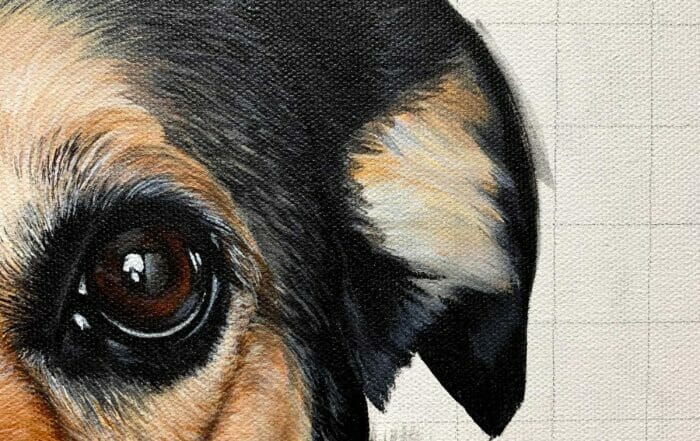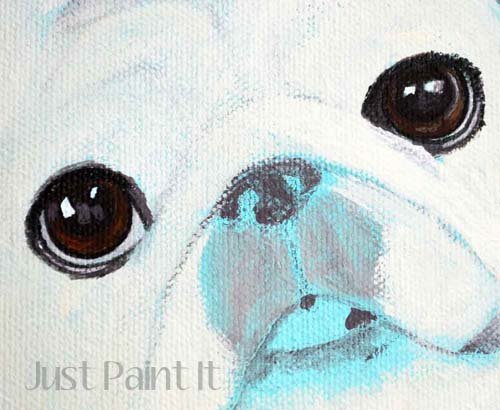To paint a dog’s eyes, start by sketching the eye shape lightly with a pencil. Then, use a fine brush to apply the base color and add details for realism. How to Paint a Dog’s Eyes!
Painting a dog’s eyes can bring your artwork to life, capturing the essence of your furry friend. Eyes convey emotions and personality, making them a focal point in any portrait. Understanding how to depict the unique features of a dog’s eyes is essential for any artist.
Focus on the shape, color, and reflections to create depth and realism. Using high-quality paints and brushes will enhance your work. This guide will help you master the techniques needed to paint stunning dog eyes that truly reflect their character. Get ready to unleash your creativity and showcase your skills!

Credit: www.momilotta.com
Table of Contents
Introduction To Canine Portraiture
Canine portraiture captures the unique spirit of dogs. Artists aim to depict their beauty and personality. Painting a dog’s eyes is crucial for this expression. The eyes reveal emotions and character.
The Allure Of Painting Dogs
Painting dogs is a rewarding experience. Many artists find it enjoyable for several reasons:
- Emotional connection: Dogs show love and loyalty.
- Variety: Each breed has distinct features.
- Challenge: Capturing emotions requires skill.
- Joy: Finished portraits bring happiness to owners.
The allure lies in capturing these qualities. A well-painted dog portrait tells a story. It highlights their personality and charm.
Challenges In Capturing Canine Expressions
Painting a dog’s eyes comes with challenges. Artists face difficulties in various aspects:
- Understanding anatomy: Knowing eye structure is essential.
- Capturing light: Eyes reflect light differently.
- Conveying emotion: Each expression tells a unique story.
- Color matching: Finding the right shades is tricky.
Each challenge requires practice and patience. Artists must observe dogs closely. They need to understand how expressions change. This knowledge helps create lifelike and engaging portraits.
Setting The Scene
Creating the perfect setting is vital for painting a dog’s eyes. A good environment helps capture the essence of your subject. Choose a photograph that highlights your dog’s unique features. Understand their personality to bring life to your painting.
Choosing The Right Photograph
Selecting the right photograph is crucial. Look for images that showcase clear details. Here are some tips:
- Use high-resolution images for better clarity.
- Choose photos with good lighting to highlight the eyes.
- Find images that capture the dog’s expression.
A photograph with a direct gaze will help create depth. Consider images that show the dog’s personality. These details will shine through in your painting.
Understanding Your Subject’s Personality
Every dog has a unique personality. Understanding this helps in painting their eyes. Here are some traits to consider:
| Personality Trait | Eye Characteristic |
|---|---|
| Playful | Bright and lively eyes |
| Calm | Soft and gentle eyes |
| Curious | Widened eyes with focus |
| Protective | Intense and watchful eyes |
Observe your dog during different activities. Take notes on their expressions. This will help convey their spirit in your artwork.
Materials You’ll Need
To paint a dog’s eyes beautifully, gather the right materials. Quality tools make a big difference. Here’s a list of essential items you will need.
Selecting Paints And Brushes
Choosing the right paint and brushes is crucial. Here are some options:
| Type of Paint | Recommended Brands |
|---|---|
| Acrylic Paint | Liquitex, Golden |
| Watercolor Paint | Winsor & Newton, Van Gogh |
| Oil Paint | Gamblin, Grumbacher |
Brushes come in different shapes and sizes. Select brushes based on the detail needed:
- Round Brushes for details.
- Flat Brushes for larger areas.
- Liner Brushes for fine lines.
The Importance Of A Good Canvas
A good canvas ensures your painting lasts. It also helps colors pop. Here are options for canvases:
- Stretched Canvas – Ideal for acrylics and oils.
- Cotton Paper – Great for watercolors.
- Wood Panels – Excellent for detailed work.
Choose a size that fits your project. A larger canvas gives more space for details. A smaller canvas is easier to manage.
Gather these materials. You’re now ready to create stunning dog eyes.
Sketching The Basic Outline
Creating a realistic painting of a dog’s eyes starts with a solid outline. This step helps set the foundation for details and colors. A precise outline will guide your painting process.
Getting The Proportions Right
Proportions are crucial for a lifelike representation. Follow these tips to achieve accurate proportions:
- Observe the dog’s face closely.
- Use light pencil strokes for easy adjustments.
- Measure the width and height of the eyes.
- Keep the distance between the eyes in mind.
Use a reference photo for better accuracy. Compare your sketch with the photo often. Adjust as needed to maintain correct proportions.
Marking The Eyes’ Position
Positioning the eyes correctly enhances realism. Follow these steps to mark their position:
- Draw a horizontal line for the eye level.
- Use vertical lines to indicate the center of each eye.
- Mark the outer and inner corners of the eyes.
- Sketch the basic shape of the eyes, oval or almond.
Ensure both eyes are symmetrical. Check the alignment frequently. This will help your painting look balanced.
The Art Of Painting Dog Eyes
Painting a dog’s eyes brings life to your artwork. The eyes capture emotion and character. Mastering this skill enhances your painting significantly. Focus on the details for stunning results.
Capturing The Sparkle
Every dog has a unique sparkle in their eyes. This sparkle shows their personality. To capture it:
- Use bright highlights.
- Choose a lighter color for the reflection.
- Apply small dots or strokes for realism.
Observe real dogs. Notice how light reflects in their eyes. Use references to guide your painting.
Shading Techniques For Depth
Shading adds depth to the eyes. It creates a three-dimensional effect. Use these techniques:
- Start with a base color.
- Add darker shades around the edges.
- Blend softly for smooth transitions.
- Highlight the center with a lighter tone.
Remember to layer your paint. This builds richness and depth. Always work from dark to light.
Practice different breeds. Each dog’s eyes vary in shape and color. Experiment with various techniques to find your style.
Adding Details And Texture
Adding details and texture to a dog’s eyes brings your painting to life. This step enhances realism and captures the unique personality of your furry friend. Focus on two main areas: the fur around the eyes and the emotions reflected through details.
Fur Around The Eyes
The fur around the eyes adds depth and character. Pay attention to the following tips:
- Color Matching: Use colors that match the dog’s fur.
- Brush Techniques: Use a fine brush for soft strokes.
- Layering: Apply multiple layers for richness.
- Direction: Paint in the direction of fur growth.
Start with a base color. Gradually add highlights and shadows. This technique creates a three-dimensional effect. Blend colors gently for a smooth transition.
Reflecting Emotions Through Details
Eyes are windows to a dog’s soul. Capture emotions through small details:
- Highlight Placement: Add bright spots for liveliness.
- Shadows: Use darker shades to show depth.
- Eyebrow Fur: Paint fine lines above the eyes.
- Expression: Focus on the shape of the eyes.
Emphasizing these details evokes feelings. A joyful dog has bright eyes. A sad dog shows softer, darker hues. Capture each emotion to tell a story through your art.
Finishing Touches
The finishing touches bring your painting to life. Focus on small details. These details enhance realism and depth in your artwork.
Blending Colors For Realism
Blending colors creates a natural look. Use a soft brush for smooth transitions. Follow these steps:
- Choose your colors carefully.
- Use a clean brush to mix colors.
- Apply light strokes to blend edges.
- Gradually build up layers for depth.
Consider these tips:
- Start with base colors.
- Add darker shades for shadows.
- Use lighter shades for highlights.
- Mix colors on your palette before applying.
Evaluating Your Work From A Distance
Step back and observe your painting. Distance helps you see overall balance. Check for any areas needing adjustment. Focus on these points:
- Are the colors harmonious?
- Do the eyes look lively?
- Is the detail consistent throughout?

Credit: www.studioeriksdotter.com
Beyond The Canvas
Painting a dog’s eyes is more than just a skill. It’s about capturing the soul. The right framing and sharing techniques enhance your artwork’s beauty.
Framing Your Artwork
Framing your painting adds elegance. It also protects your artwork. Here are some tips for choosing the right frame:
- Size: Match the frame size to your painting.
- Style: Choose a frame that complements your art style.
- Color: Use colors that enhance the painting’s mood.
- Material: Wood frames give a classic look; metal frames provide a modern feel.
Sharing Your Work With The World
Once your painting is ready, share it! This increases visibility. Here are some effective ways to showcase your art:
- Social Media: Use platforms like Instagram and Facebook.
- Art Communities: Join online forums and groups.
- Local Exhibitions: Participate in community art shows.
- Personal Website: Create a site to display your portfolio.
Engage with your audience. Ask for feedback on your work. This builds a loyal following.

Credit: www.momilotta.com
Frequently Asked Questions
How Do I Choose Colors For A Dog’s Eyes?
Choosing colors for a dog’s eyes depends on the dog’s fur and overall color scheme. Observe the natural eye color and consider complementary shades that enhance the painting. Experiment with different hues to see what resonates best. Always aim for realistic tones to maintain authenticity in your artwork.
What Materials Are Best For Painting Dog Eyes?
For painting dog eyes, use high-quality acrylic or watercolor paints. These materials provide vibrant colors and easy blending. Additionally, use fine brushes for detail work. A good canvas or thick paper is essential to support the paint and texture. Always have a palette for mixing colors effectively.
Can I Paint My Dog’s Eyes Without Prior Experience?
Yes, you can paint your dog’s eyes without prior experience. Start with basic techniques and practice on simpler subjects. Follow tutorials to build your skills gradually. Remember, patience and practice are key. Enjoy the process and don’t be afraid to experiment with different styles.
How Long Does It Take To Paint Dog Eyes?
The time it takes to paint dog eyes varies by skill level. Beginners might spend a few hours, while experienced artists could complete it in an hour. Allow for drying time if using layered techniques. Plan to take breaks to assess your work and make adjustments as needed.
Conclusion
Painting a dog’s eyes can bring your artwork to life. With the right techniques, you can achieve stunning results. Remember to practice and be patient with yourself. Each brushstroke adds character and emotion. Enjoy the process, and let your creativity shine through in your pet portraits.
Happy painting!



